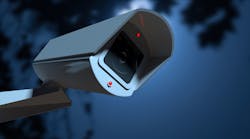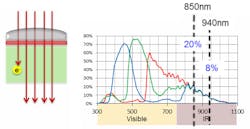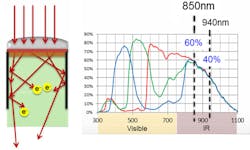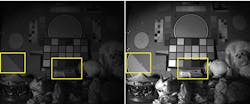OmniVision Technologies’ Nyxel near-infrared technology significantly improves a camera’s low light operation. The typical camera sensor can be used in low light conditions, but the sensor response at 850 and 940 nm tends to be lower than with visible light (Fig. 1). Part of the issue is that the sensors typically capture incoming photons that come in perpendicular to the sensor. The incoming light will be detected better if the depth of the sensor is increased, but this brings up issues like crosstalk between cells.
The Nyxel technology adds three pieces to the puzzle. The first is increasing the thickness of the silicon, which allows the photons to travel further in the pixel cell and enables more electron to photon conversion hence a brighter image. The second is essentially putting each cell into its own deep trench with barriers between cells to avoid photon travel to the neighboring pixels and prevent crosstalk (Fig. 2). The other is to add a layer on the surface that absorbs the maximum amount of light. This combination provides a longer path, allowing the sensor to detect more photons and improve the overall performance of the system. The addition of the Nyxel support does not reduce the performance of the sensor for visible light. It also does not reduce the frame rate for visible or infrared sensing.
The performance graphs highlight the improvements of the Nyxel technology at 850 and 940 nm. There is a three times improvement for 850 nm(t0 60% quantum efficiency) and a five times improvement for 940 nm (to 40% quantum efficiency). These two wavelengths are the most commonly used near-infrared LED illuminators, both of which are just outside of the visible light spectrum.
The effect of the Nyxel technology is apparent when viewing comparable images using the existing and new sensors (Fig. 3). The camera with Nyxel technology provides a brighter picture, with more contrast allowing viewers to see more detail.
Providing improvements for near-infrared (NIR) sensitivity has benefits for a variety of applications. For example, it can extend the battery life of mobile applications that use IR illuminators to improve camera operation. It can provide longer range image capture because of a higher sensitivity. Likewise, it will provide clearer and crisper images in low to no ambient light conditions compared to non-Nyxel equipped sensors.
The Nyxel technology can be applied to across the board, so one can expect to see it being incorporated throughout the OmniVision line of sensors. For now, Nyxel technology will target a few cameras providing a range of performance options in terms of resolution and frame rate.




